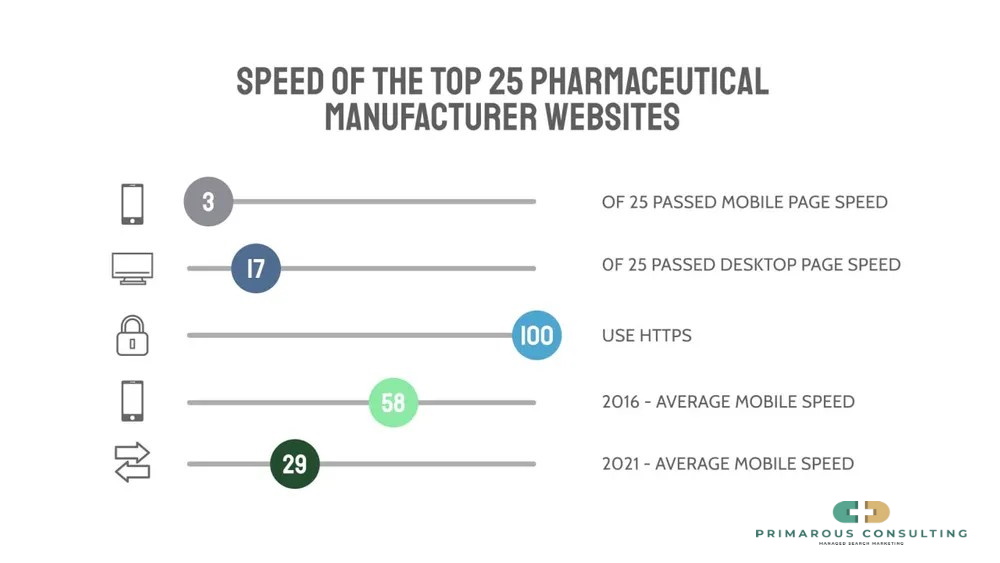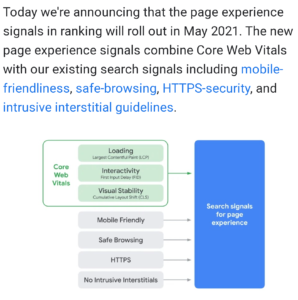
Primarous Consulting, a leading provider of managed pharmaceutical search marketing services, recently completed a review of the Top 25 Pharmaceutical Manufacturers corporate websites, analyzing each website for the use of primary search engine optimization features.
The elements analyzed included: organic optimization, site speed, site mobile-friendliness, site security, and engagement with Google.
The purpose of the search analysis is to:
1) measure how well the Top 25 Pharma Manufacturers meet Google’s current and pending Search Standards,
2) to understand if progress has been made over the last 5 years, and
3) to provide a benchmark for other pharmaceutical companies to measure their own search status.
This is a follow-on survey to a similar analysis completed in 2016. In 2016, the survey was mostly concerned with the move to the ‘mobile-first index’ and the use of HTTPS for security. In 2021, the focus is primarily on mobile page speed and usability.
Key Findings:
In the upcoming May 2021 Update, Google is placing tremendous value on mobile page speed and the mobile user experience and pharma websites are not ready!
- None of the top 25 pharmaceutical manufacturer websites pass the Google Core Web Vitals (CWV) test. Core Web Vitals Will become a Google ranking factor in May of 2021
- 88% of the analyzed sites currently fail Google’s mobile speed test
- The top 25 pharmaceutical companies have made considerable progress in the adoption of HTTPS, moving from 38% adoption in 2016 to 100% in 2021.
- 96% of the analyzed sites are now mobile-friendly, up from 76% in 2016.
There has been a significant decline in mobile page speed, as reported by Google’s PageSpeed Insights. This is not because the sites have gotten slower, but because Google continuously changes the metrics. Site speed is a moving target and will require continuous attention to stay ahead of Google’s changes.
This is important because search visibility is the key to effective online marketing for pharmaceutical companies and brands. Simply put, if audiences can’t quickly find content, they can’t engage with it.

PRIMAROUS CONSULTING TOP 25 PHARMA SURVEY RESULTS
In 2016 Google was focused on:
- website mobile-friendliness
- HTTPS use
- page load speed
The Findings – 2016 Survey
- 24% of the top pharmaceutical manufacturer’s websites failed Google’s mobile-friendly test
- 72% had not implemented HTTPS (secure website)
- 64% failed Google’s mobile speed test
- 100% of the top pharmaceutical manufacturers had not claimed their business data in Google.
In 2021 Google is focused on:
- Page User Experience – mobile page speed
- Core Web Vitals – specific elements of mobile user experience
- Measuring E.A.T – Expertise, Authority, Trustworthiness
The Findings – 2021 Survey
- 92% of the top pharmaceutical manufacturer’s websites now pass Google’s mobile-friendly test
- 100% have implemented HTTPS (secure website)
BUT - 92% fail Google’s mobile speed test (2 of 25 above 50)
- 100% of the top 25 pharma manufacturer sites fail to meet Google CWV standards
- 74% of the top pharmaceutical manufacturers have not claimed their business data in Google.
Search visibility is determined by multiple factors – including website content, mobile-friendliness, and page load speed. There are as many as 200 to 300 different ‘signals’ search engines weigh when evaluating the relevance of a website’s content. Content is ranked in the search results based on its relevance to the search that the user has made.
Changes in the way these signals are weighted are called algorithm changes and they can happen daily, so not all changes are equal.
Some major algorithm updates can fundamentally change the way websites are measured and ranked. These disruptive updates are usually only known after the fact.
In a very few cases, Google has given advance notice of a pending change to site owners. Core Web Vitals is such a case.
owners. Core Web Vitals is such a case.
The Core Web Vitals update was announced in November of 2020 and will go live in May of 2021.
A very brief history of some other recent Google algorithm updates and what they impacted:
Hummingbird (2013) – focused on search context and long-tail keywords, conversational queries and understanding of user intent
E.A.T (2014) – initially focused on subjects related to YMYL (your money or your life), Expertise, Authority and Trust standards apply directly to the pharmaceutical industry and clinical research.
Mobile Update (2015) –prioritized mobile-friendly sites in mobile search, this was the first update where Google gave advance notice, and it has proven to be an extremely important ranking factor.
Mobile-First Indexing (2018) – Google begins indexing the mobile version of webpages for the purpose of indexing and ranking
BERT (2019) – brings NLP (natural language processing) and machine learning further into the mix, to better understand context and conversational queries
Google Page Experience Update and Core Web Vitals (2020/21) – focused on page mobile speed, mobile friendliness and security as well as addressing specific technical aspects of mobile page load and the mobile user experience.
Top 25 Pharmaceutical Manufacturers – the List
For the purpose of the 2021 review, Primarous Consulting used data from Contract Pharma’s 2020 list of Top 25 Pharmaceutical and Biopharma Companies, based on 2019 publicly available sales data.
For the 2016 survey, we used data from the 2014 PM Live Top 25 list, based on data from GlobalData. The ranking was based on global revenue figures, including prescription medicines and generics.
THE REVIEW PROCESS
Each website was evaluated for: 1) mobile and desktop site speed, 2) mobile-friendliness, 3) Use of HTTPS, 4) Core Web Vital status, 5) the use of even minimal organic search optimization, and 6) the status of the corporate business data on Google
Elements 1-4 were checked using Google’s Publicly Available Mobile-Friendly and Page Speed Tests
https://www.google.com/webmasters/tools/mobile-friendly/
https://developers.google.com/speed/pagespeed/insights/
Elements 5 and 6 were determined by manual review
SEARCH MARKETING BASICS
Typical Search Result Example
Many pharma marketing professionals are unaware that the content appearing in search results comes from multiple sources.
In the search example below, we highlight the 4 primary data sources; paid ads, map results, business data and organic results. All of these sources can be managed or influenced to build online visibility.

Explanation of Search Result Types
The following information is focused primarily on Google because Google controls 90% of global search activity and 86% of US mobile search. Statements made about Google apply to Yahoo and Bing as well. Together these three represent 97% of all searches made.
Paid Ads – Paid ads can appear within search results pages on search engines like Google, Yahoo and Bing and on social sites like LinkedIn or Facebook. While paid advertising has a strategic role, fewer than 20% of users ever click on paid ads.
Map Results – Google Map data is often shown in conjunction with Google Business data. Maps data refers to all physical locations in the Google database. Duplicate or extraneous data can be deleted, physical map locations corrected, and standardized. NAP data (name, address, phone) and other information is managed via Google Maps.
Business Results – Google Business data can appear in many places across Google and includes company-specific content such as the business’s logo, categorization, web links, pictures, reviews, videos, and more. This data is managed and optimized via Google My Business.
Organic Results – Also called ‘natural’ or ‘middle of the page’ results, these are the most trusted by users and generate more clicks than any other result types. Companies achieve visibility in the organic results through the process of SEO or search engine optimization.